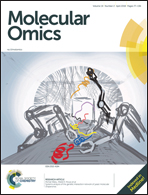Identification of PP1–Gadd34 substrates involved in the unfolded protein response using K-BIPS, a method for phosphatase substrate identification†
Abstract
Phosphorylation is a key post-translational modification in cell signaling, which is regulated by the equilibrium activities of kinases and phosphatases. The biological significance of many phosphorylation events remains poorly characterized due to the scarcity of tools to discover phosphatases substrates. In prior work, we established kinase-catalyzed biotinylation where kinases accept the γ-modified ATP analog, ATP-biotin, to label phosphoproteins. Here, we developed a novel method to study substrates of phosphatases using kinase-catalyzed biotinylation termed K-BIPS (Kinase-catalyzed Biotinylation to Identify Phosphatase Substrates). In a proof-of-concept experiment, K-BIPS was initially used to explore the substrates of phosphatases inhibited by okadaic acid. Many known phosphatase substrates were observed, confirming K-BIPS as a valid phosphatase substrate identification tool. Then, as a further application, K-BIPS was used to discover the substrates of the PP1–Gadd34 phosphatase complex in the context of unfolded protein response (UPR). In addition to the known substrate eIF2α, K-BIPS revealed several novel substrates, suggesting a more prominent role for the PP1–Gadd34 complex in UPR than previously appreciated. Overall, the two studies establish K-BIPS as a powerful tool to discover the cellular substrates of phosphatases.



 Please wait while we load your content...
Please wait while we load your content...